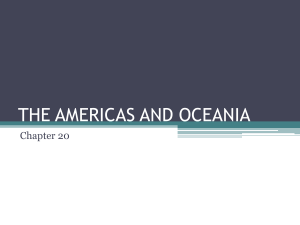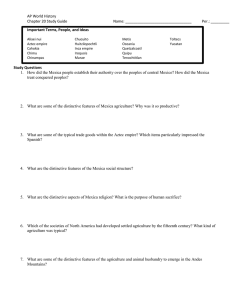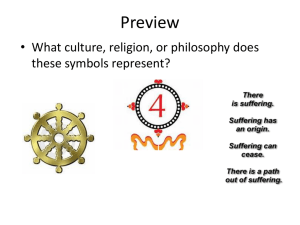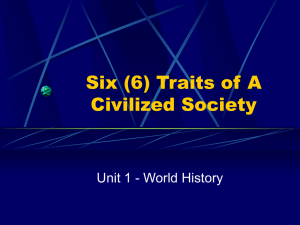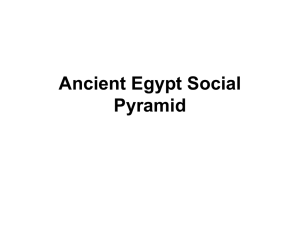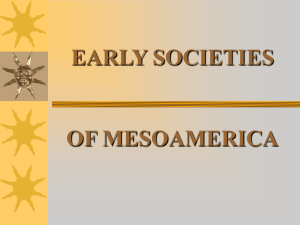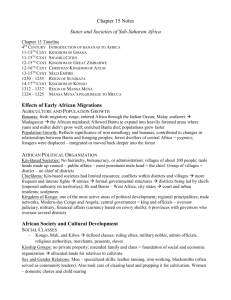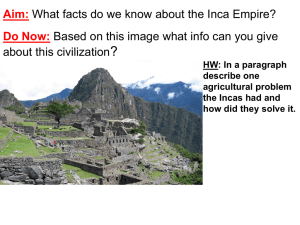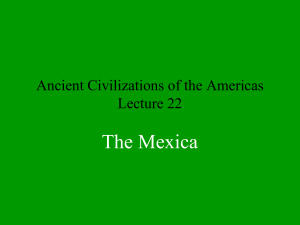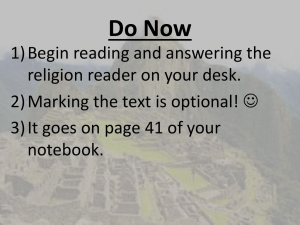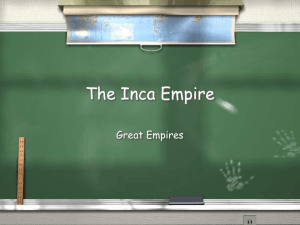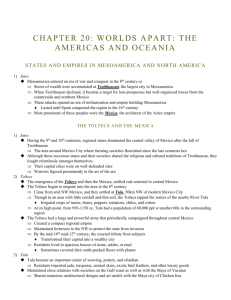File - Ms. Myer`s AP World History
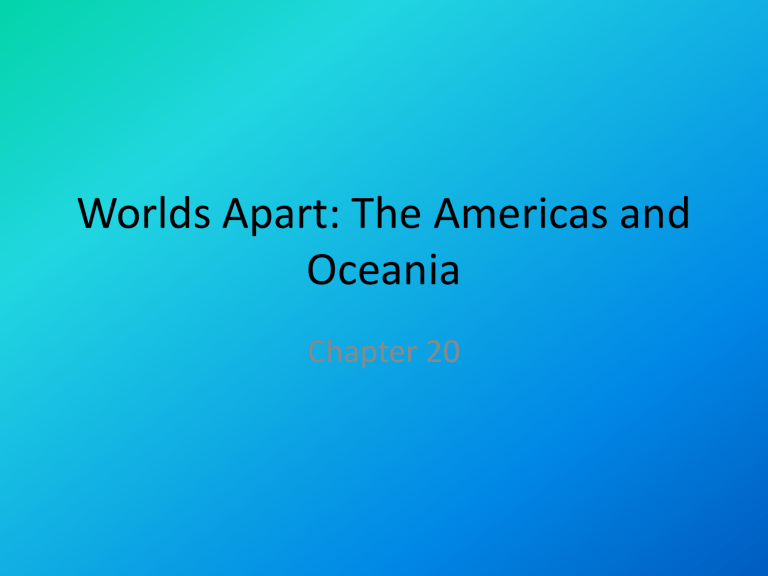
Worlds Apart: The Americas and
Oceania
Chapter 20
I: Where we left off
• Olmec (->) Maya (->) Teotihuacan
• After decline of Teotihuacan, lots of wars and conquest
• Militarization and empire-building (esp. the
Mexica)
I: The Toltecs
• 9 th and 10 th century, Valley of Mexico:
Teotihuacan successor states (shared culture, but lots of fighting)
• Toltecs: formed compact empire
– Irrigation agriculture
– Urban and rural pops.
– Powerful army and fortresses
– Tribute -> wealth
I: The Toltecs (cont.)
• Toltec capital: Tula
– Also, manufacturing center (weaving, pottery, and obsidian)
– Trade with Maya and Gulf Coast
– Decline: conflicts between ethnic groups, too many migrants, destructive fire
I: The Mexica
• Had migrated into V. of Mex. from NW -> bad reputation (origin story)
• C. 1345: settled on an island in Lake Texcoco =>
Tenochtitlan
– Advantages: food source, chinampas, defensive
I: The Mexica (cont.)
• Early 15 th century: defeated neighbors -> tributary relationships
• Imperial expansion: often violent, colonists resettled some areas
• Allied with Texcoco and Tlacopan to guide empire
-> Aztec Empire
I: The Mexica: Trade and Tribute
• Main goal: tribute from subjects (esp. foodstuffs and manufactured items)
• State-sponsored merchants traded for luxury items (and pol/mil info), but weren’t trusted
• Tenochtitlan had huge market
• No elaborate bureaucracy for admin – relied on locals to govern and collect tribute
• No standing army – ruled through fear
I: Mexica Society
• Social structure: rigid hierarchy – elites (rulers, priests, warriors), commoners (farmers, artisans, merchants), slaves
• Warriors: honors, wealth, and land; conspicuous consumption (by law)
• Women: no role in political affairs; influence in family and honor as mother of warriors
– Role = have babies, esp. warriors
I: Mexica Society (cont.)
• Priests: special edu. in calendar and ritual lore, presided over religious ceremonies, read omens
• Cultivators: farmed family lands; also, worked aristocrats’ land, and on public works projects; paid taxes of crops
• Slaves: domestic servants; debtors or criminals
• Artisans: prestige for skilled artisans
• Merchants: important, but viewed as profiteers
I: Mexica Religion (cont.)
• Adopted many traditions of the area: ball game, solar and ritual calendar
• Gods: 2 main – Tezcalipoca and Quetzalcoatl
(common in Mesoamerica)
• Ritual bloodletting: blood symbolizes water for maize; self-sacrifice to insure continuation
• Huitzilopochtli: patron deity; human sacrifices to keep him happy; victims (criminals, tribute,
POWs); religious, not entertainment
I: Peoples and Societies of the North
• Variety of pol, soc, econ, & cult traditions in N.A.
• Lots of h/g (small-scale society)
• Some areas supported large-scale, sedentary, agricultural societies
– SW: Pueblo and Navajo
– NE: Iroquois (women were in charge of villages and farming, men hunting, fishing, and war)
I: Peoples of the North (cont.)
• Moundbuilders: eastern woodlands
• Built mounds for ceremonies, dwellings, and burials
• Largest: Cahokia – trade center
• No writing, social classes, LD trade (via canoe)
II: States & Empires in South America
• Where we left off: Chavin and Moche
• After disappearance ->warring, regional states
• mid-13 th centuries: migrants around Lake Titicaca
• 1438: military campaigns expanded authority (N and S, then coast)
• By late 15 th century: large empire from Andes to the coast =>
Inca Empire
II: The Inca Empire
• Inca ruled as military and administrative elites
– Armies of the conquered
– Bureaucracy
– Obedience through hostage-taking and loyal colonists
– Rebellion -> resettlement
– Taxes supported rulers and admin.
– Extensive road network (communication, mil. Movement, runners)
– Quipu for record-keeping
– Capital = Cuzco (admin., rel., and ceremonial center) – very lavish
(lots of gold)
II: Inca Society
• Trade: controlled by gov’t; no large class of merchants or artisans; local barter
• Ruling Elites : deity descended from sun, owned all land and property, mummies governed
• Aristocrats : conspicuous consumption (ear spools)
• Priests : aristocrats, celibate/ascetic
II: Inca Society (cont.)
• Peasants : small villages/towns, ownership by extended families – allocated to individuals
– Also, worked state lands (but, no taxes) -> elites and surplus
– Also, owed compulsory labor service (men construction, maintenance, women – textiles, pottery, etc.)
II: Inca Religion
• Inti (sun god, temples with many priests and attendants) and Viracocha (creator god)
• Pilgrimages to temple, elaborate décor, sacrifices of agricultural produce and animals
• Moral thought: concept of sin, life after death (rewards and punishments based on life), confession and penance
III: The Societies of Oceania
• Australian nomads: h/g
• “natural” specialization (<- environment) -> regional trade of surplus foods and small items
• Limited trade with other areas (N.G., SE Asia)
• Importance of local geography in religion
III: Pacific Island Societies
• By early CE: agri. soc. on in all major island groups
• Starting 1000 CE: increasing pop. -> soc and pol development
• Trade between islands : central and west – regional trade networks
• Within island groups: trade had soc, pol, and econ functions
III: Long Distance Voyages
• East: trade was harder due to distances, but some voyages occurred
– E.g., to South America (got sweet potatoes -> spread)
• Population growth: productive farming and fishing
(fishponds in HI) -> pop. growth
– Dense pop -> envir. degradation and social issues (e.g.,
Easter Island)
III: Polynesian Chiefdoms
• Dense pop -> complex pol org (strong, centralized states/monarchies)
– -> specialization (farming, axes, canoes)
– -> classes: ruling elite and aristocrats (made decisions and collected surplus), priests, skilled artisans, commoners
– Chiefdoms : some expanded to other islands
(unsuccessful); allocated land, mobilized construction labor, organized military forces; conspicuous consumption
III: Polynesian Religion
• Priests = intermediaries between humans and gods
• Common gods: war & agriculture, plus local deities
• Common temple structure for worship, sacrifice, communication with gods
